Video Recap: Muncho Lake, Bootski Lake and Liard Hot Springs
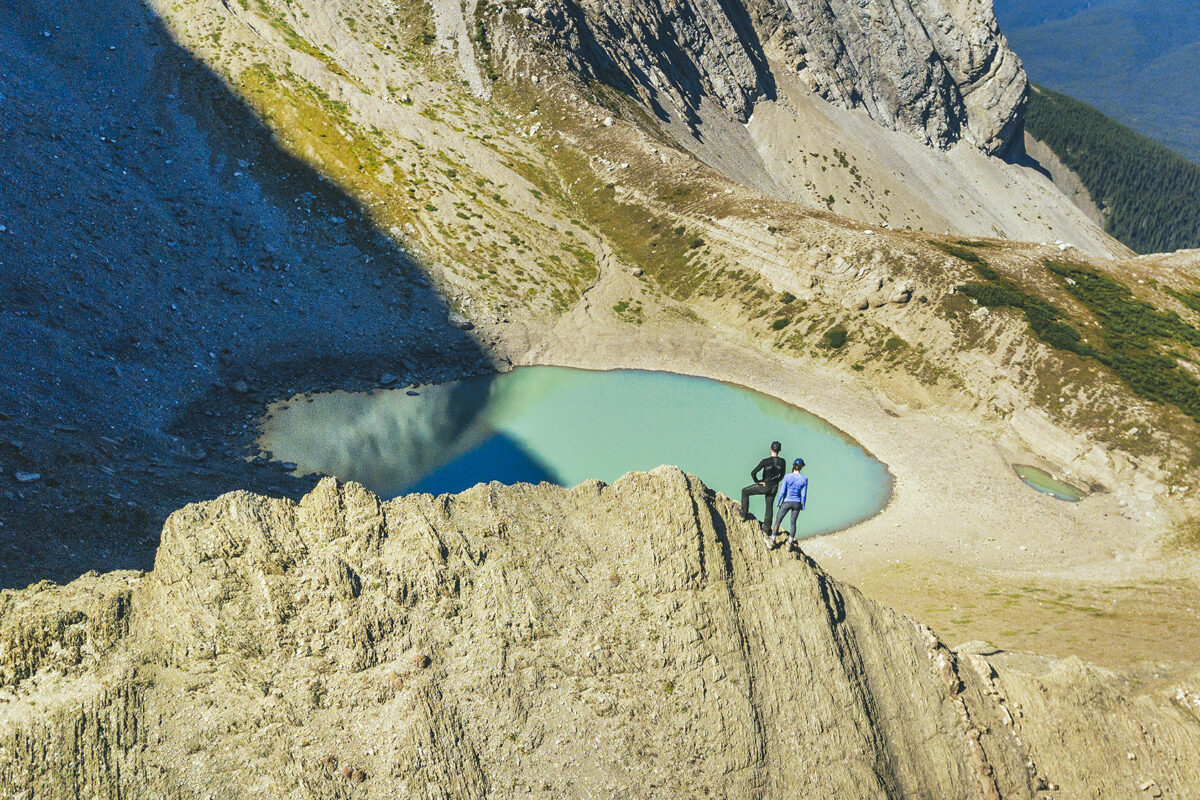
Our adventures around the world…

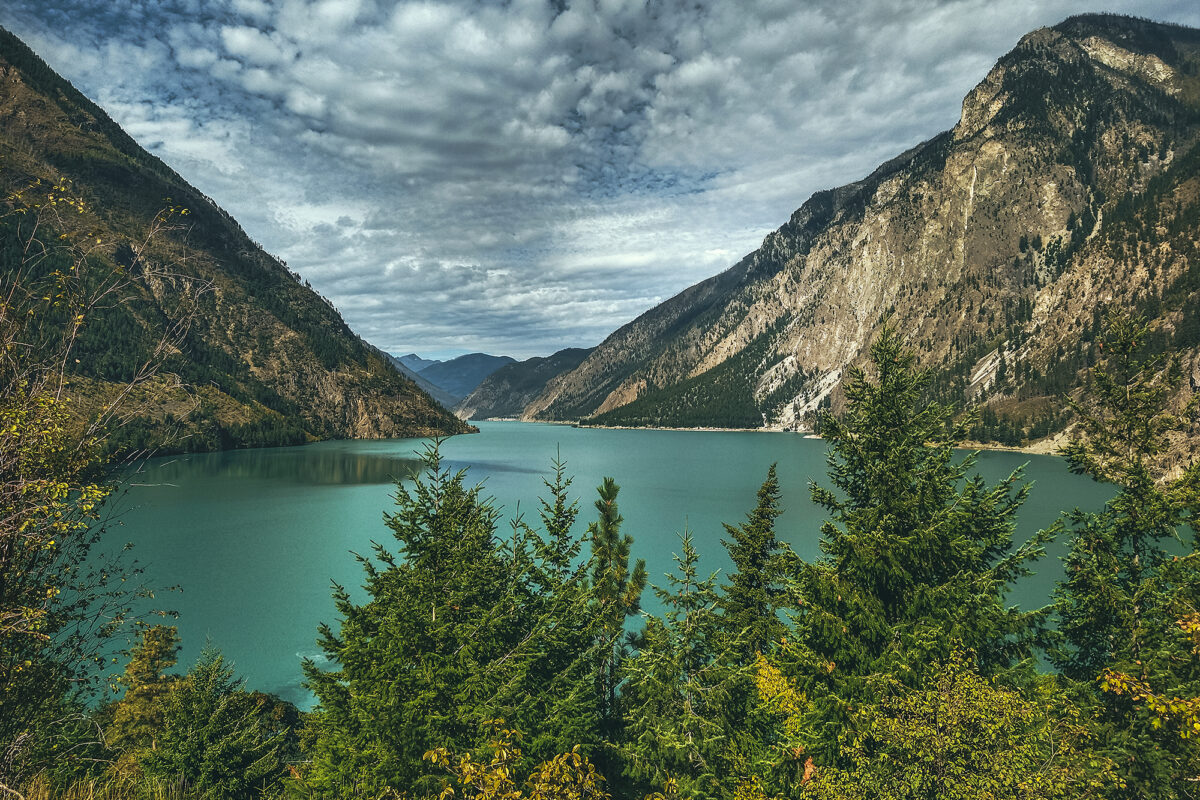
After a restful night, we packed up camp and went for a quick exploration of what initially put Tumbler Ridge on the tourist map: Dinosaurs.
The town is fairly young, as it was built in the early 1980s as part of a huge coal mining project in the area. The mining went on for a little less than 20 years, and with the activity reducing and people moving away, Tumbler Ridge was at risk of becoming a ghost town. If it weren’t for two kids going tubing down the river one day. After falling off their tubes, they climbed on the shore and found what they thought looked like dinosaur footprints. After some nagging, they convinced their dad to send photos to a paleontologist, who indeed confirmed they were right. Turns out there were multiple tracks on the river shore, and in other areas nearby. Scientists came to explore further, ultimately discovering actual bones and other fossils. Thanks to those discoveries, and the natural wealth of the area, Tumbler Ridge is now a recognized UNESCO Geopark. We visited the Dinosaur gallery, which features replicas of the species that would have left the tracks, as well as molds of the actual footprints, and the (partial) skeleton of the first dinosaur found in BC.
After that we decided to go see the tracks on-site. We walked the 3km (round trip) trail to Flatbed creek, where the tracks were found. There are two very distinct foot prints just as the trail meets the creek, which were easy to spot.
We crossed the creek to see the tracks on the other side (those that were first spotted by the kids), but those are quite faint and hard to see in daylight. In the summer, the visitor center offers guided tours in the evening hours, to see them under electric light (easier to see them with cast shadow). However, tours were finished for the season, plus we were leaving that day, so we didn’t get to experience that.
Even then, it was pretty incredible to see these two foot steps, neither of us had seen real life dinosaur traces on-site before, kind of blows your mind to think they stood there 100 million years ago, and their mark is still imprinted in the rock, even after the position of tectonic plates have changed, entire mountain ranges have formed around them, and they’re not even at the same longitude they were back then!
It was 2 o’clock once we were done with all the dinosaur attractions, so we got some lunch at the grocery store and headed out. We stopped at Gwilliam lake to eat, a lovely little picnic spot, then drove to Chetwynd.
Chetwynd would likely be another small town on the highway if it weren’t for the very impressive display of chainsaw wood carvings visible along the road. Started in 2005, there is a carving competition every year in June and the result has become the town’s main reason for tourists to stop.
The sculptures were all really remarkable, especially knowing they were all done want by chainsaw – makes me want to look up videos on youtube to find out how they get that much detail with such a big tool.
After Chetwynd, we set off to find a campsite for the night, and had no trouble finding a spot at the first provincial park we came across, Heart Lake, in Pine Le Morray provincial park.
We were back to the more standard camping experience that we’d been having along the way – relatively private site in the trees with a lake nearby, and friendly but distant neighbors (and remarkably clean and toilet-paper-stocked out houses).
That night though I had a mild panic attack upon waking up in the dark to the sounds of storm, wind, rain, cracking trees, and some loud metallic ruckus that my brain couldn’t quite make sense of, while trying to determine which of these noises might be caused by wildlife (spoiler alert: none of them were). But in my half-asleep state I experienced some kind of sensory overload, until Brice pointed out that the metallic sounds were construction machinery (“you can tell by the bip-bip sound of a truck backing up”), and not by a bear aggressively knocking over garbage cans, which my groggy-self was convinced of. In fact, there was excavation work being done across the road, along with a 1:30am train coming by. Thankfully it seemed to quiet down (and so did my brain) after the train passed and we could sleep the rest of the night undisturbed.
In the morning, we both felt a bit of camping fatigue, and wondered if we could make it home in one day. But with at least 12 hours to drive, and add 2-3 hours between lunch and other stops, that seemed like a rather brutal travel day.
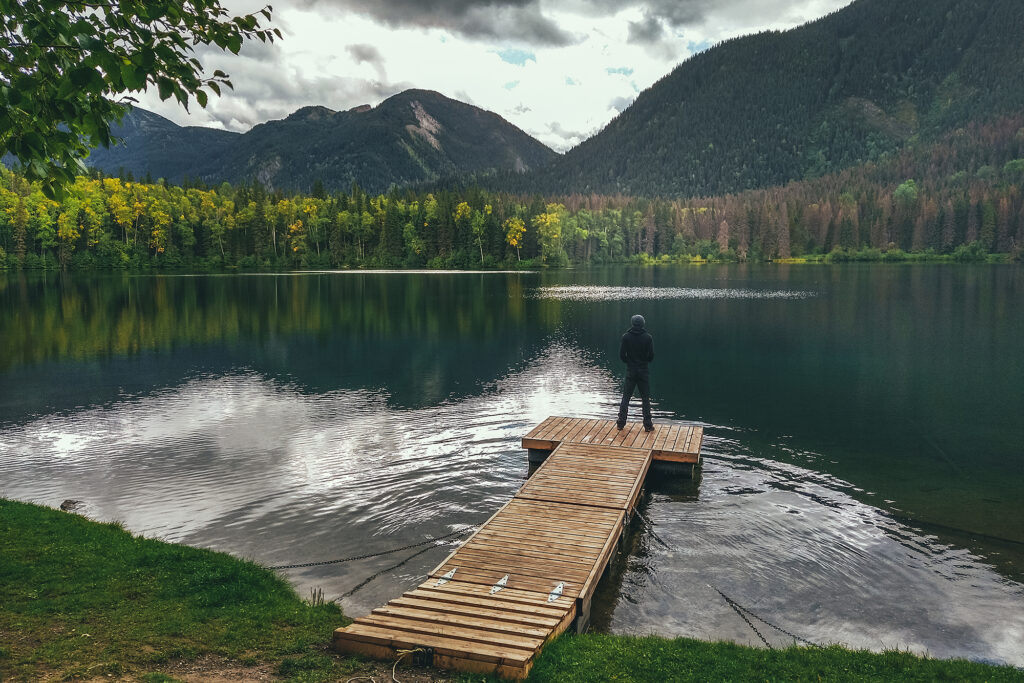
We could also try to drive as far as possible passed Prince George, and try to get home the next day, but then we might hit the end of long week-end traffic congestion, and no one wants to get stuck in Lions Gate Bridge traffic after driving over 9000km up and down the country – that’s no way to end an epic road trip. So we agreed that spending a couple more nights camping would be fine, and decided to even take another short side-trip, might a well since we were only a couple hundred kilometers from Prince George, and didn’t particularly need or want to spend time in the town itself.
So we drove to Mackenzie, BC, after I had read that you could pretty much drive most of the way up Morfee Mountain, for easy views. And so we did. The dirt road took us almost to the summit and we then hiked 5min up the hill to get a slightly higher vantage point on a scenic view of the valley around, the town and lake in the distance.
Then we drove down to Morfee Lake to have a pleasant lunch by the water. The rest of the day was spent driving. The only stop I wanted to make in Prince George was at Terry’s Fresh Hot Bannock, a place that made donut-like bannock. But like many places along the that way we reached on a weekend, it was closed on Sundays. With that, we picked the first provincial park within the next 150 km and landed at Ten-Mile Lake, near Quesnel, to spend the second to last night on the road.
We left the campsite around 11 am, after taking our time for breakfast. We decided to go home through Lillooet and the Sea to sky Higway, rather than Merritt / Hope like we did a month prior. Some of it was to avoid the fire areas, especially since there was now a large fire zone on the Coquihalla highway, and also it was good way to have one last night near home but still in a remote area.
We pretty much drove from 11am to 5pm, with a quick stop in Williams Lake pick up some lunch, which we then ate at Lac La Hache . We made a quick stop at Marble Canyon Rec Site, to stretch our legs, then drove to Kwotlenemo (Fountain) lake, a familiar campsite where we had stayed twice before. We were easing back into everyday life by camping into a familiar spot.
The next day we drove through Lillooet and Pemberton aka the scenic route home. We stopped quickly in Squamish to say hi to our friends Adele and Thierry, and drop off copies of the provincial/territorial tourism guides we’d picked up along the way.
Adele and Thierry had done a similar trip a few years back and lent us their guides, and now Adele was very motivated to go back the next summer, so it only made sense to pass the documentation back to them, and continue the cycle. Finally we made it back to Vancouver after 37 days and 9729 km on the road.
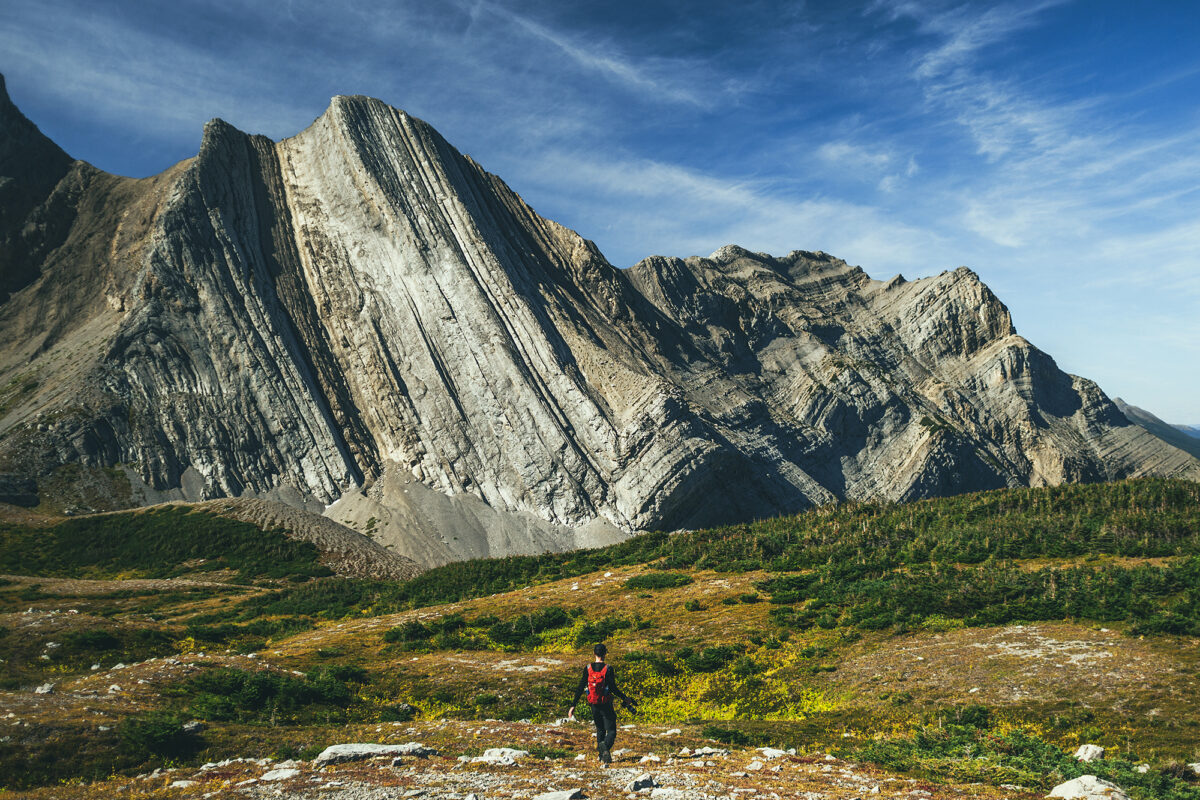
We took care of a few things in the morning while still at the house (namely, book some plane tickets to fly to Montreal literally 2 days after we’re back in Vancouver), then we headed to the Visitor center to grab a couple booklets on Dawson Creek and Tumbler Ridge. These two stops weren’t on the original itinerary, but we decided to add them as we had a bit of buffer with our return-home date.
Before leaving Fort St John, we also stopped at the indigenous Artist Market, a small shop that sells handmade crafts from local artists. They had soaps, salves, shoes, artwork, jewelry etc… I didn’t see anything that I wanted to bring back but it was a nice selection of locally-made items.
Then we left Fort St John and headed to Dawson Creek, about 1 hour away.
Dawson Creek is the historical place of the “Mile 0″, which is where the Alaska Highway officially starts. Not surprisingly, most of the town’s historical sites have to do with the highway construction in the early 1940’s. It was a beautiful sunny day, so we didn’t feel like going into the museum. Instead we took the small walking tour around the town center, which passes by a number of murals depicting some of the town’s history.
It was 4 o’clock when we headed out and we got to the Tumbler Ridge visitor Center at 5pm, right as it closed.
Thankfully, I’d picked up a full booklet about the area in Fort St John, so we were able to easily pick a hike to do the next day. We drove about 25 km out of town towards the trail head and set up camp at the Flatbed Creek Rec Site – a small site off the side of the road but right near a small creek, a pretty nice spot once again.
The next day we were planning on doing a hike called Bootski lake down a rough forest road at the edge of the park boundaries, then we thought we’d come back to this spot to camp another night.
This was the only time of this trip when we spent the night with absolutely no one around, in a fairly remote spot. If wildlife was ever going to come out, that would be it. I did a bit of a check to see if there were any traces of animals (like bear scats). We didn’t know when the last people that camped there were there, and whether they were responsible, leave-no-trace campers, or the type to leave remnants of food out after they’ve gone, attracting wildlife to the spot. Thankfully we didn’t see any traces of such behavior, or recent animal activity. We did get a visitor at night, probably a small-ish rodent type, although it sounded a bit bigger as it ran around on the tarp we’d placed underneath our tent.
The rest of the night was quiet and uneventful but we got a really nice starry sky, being pretty far from any light pollution. We hadn’t seen many stars at all throughout our trips, partly due to weather but also to the fact that the days were still quite long up in the Yukon and we rarely got a full dark night when we were there. Going back down south we could feel the days getting shorter as we got closer to Vancouver.
It took us a bit of time in the morning to get ready (if you haven’t clued in by now, it usually does, we’re not really the get-up-and-go type). Contrary to what we first had thought, we decided to pack everything up and spend the following night at a campsite back in Tumbler Ridge, partly because we didn’t want to leave our gear for any random party to find, as people would likely come to this spot to spend the week-end, and also because an in-town campsite came with the promise of showers, which we were sure to appreciate after our hike.
We drove about 13km south on highway 52.E, then 37 km down Okay Main Service Road to the trail head. There was phone service right at the FSR turn off so we made sure to let a friend know where we where going and when to expect us back, a precaution we always take when hiking in remote locations.
It was pretty sunny that day, but weary of changing conditions, and after spending the last few weeks bundled up against the elements, I still wore leggings and long sleeves – a choice I regretted as soon as we warmed up on the trail. Brice wore all black pants and long sleeve, also a questionable choice for him who generally runs hot.
The hike starts with 3.5km along an ATV track. At first we thought we could have driven some of it but it got pretty rough, probably more so than our jeep could handle. There was one creek crossing where I thought it wiser to go through barefoot, rather than risk another leg dunking. Brice as per usual skipped over those slippery rocks like it was nothing.
After 3.5km, the trail veers off into the trees and becomes a steep single track, similar to a lot of those we have around Vancouver. It was only about 1 km, but quite steep. Shortly after the start of the climb, the trail goes through a burn area, still dense with tall, charred trees. Then it’s back into intact forest again, until it reaches an open meadow with 360 views of the mountains and valley around. That view alone was quite stunning, and although some distance back, the impressive wall of Mount Waptki in the backdrop was an imposing sight.
Once we were on the meadow, the trail disappeared and we were a bit taken back, conditioned as we were to always stick to marked trails and avoid stomping on vegetation.
So we went in the general direction of the main summit and bowl (where we assumed the lake was) trying to stay mainly on rocky surface where possible.
We passed a couple with a puppy returning from the lake. They had driven their car all the way up the ATV track to the start of the single track trail, but theirs had higher clearance and a metal plate to absorb shock on the bottom, ours would definitely not have made it that far……
Eventually we reached the bowl and the view of the lake, which was really a small tarn resulting from snow melt, and visibly at its lowest after a summer of evaporating.
From there, we followed a trail going up to the lowest part of the ridge, overlooking the lake. The slope we climbed was quite steep, and all lose gravel, which I didn’t love, but i still managed to make it to the saddle.
While at the top, I marveled at the fact that this mountain was basically made of layers and layers of slate, compacted together nearly vertically, and somewhat loose as I could pull out pieces without much effort. Geology is quite something, and I know nothing about any of it, but still it makes my head spin to think about how these mountains came to be millions of years ago, and the fact that we’re ultimately sitting on a pile of rocks held together by gravity-defying friction….
After some photos and drone-flying, we made our way down in a different spot, along a “spine” of bigger rocks jutting out from the gravel and which we could grab on to while bum-sliding down.
We went down to the tarn and Brice considered going for a dip for a hot second, but to sun was rapidly disappearing behind the top of the ridge and the water was soon completely in shade, so he decided against it. We started heading back across the meadow. It took us a bit less time as we managed to connect the faint sections of trail more directly. The way down was quick and I looked forward to that barefoot creek crossing. My feet got quite hot in my hiking boot and merino socks. Looking back this would have been a great trail to do in running gear, but having never done it before, we erred on the side of steadier footwear – and more layers than we eventually needed, but that’s always what I do anyway. Even if I end up carrying four jackets in my bag, I’d rather that then get caught in the cold and have a very unpleasant experience.
We got back to the car pretty much 5 hours after we left, having spent the exact time suggested on All trails. The drive from the main road took us about 45 min each way, mainly because the 13k nearest the trailhead were very pot-hole-y and slow, whereas the first 24 kms where very smooth.
Then we drove the 35km or so back to town. According to the brochure there are 3 campgrounds in Tumbler Ridge. We went to the Lions Campground, but soon realized all the sites were reserved – it was the start of Labor day long week-end and I hadn’t thought about people going for one last camping trip before back to school. We eventually came across one site that didn’t have a reserved sign and snatched it up. Turns out it was technically reserved as we found out from the campground manager, but he admitted to having a couple of spots saved up for this exact case, so we were able to stay. It was a totally opposite experience from the night before, when we camped in complete isolation, whereas we were now surrounded by big RVs and campers, kids running everywhere and big groups of people sharing they campfire. It wasn’t unpleasant though – especially the part about not having to worry about running into wildlife at night (even though we actually never did), and the sites were pretty quiet from 9pm on, until 7.30 am the next morning.
We thoroughly enjoyed the showers, and had a lovely sleep at the campground.
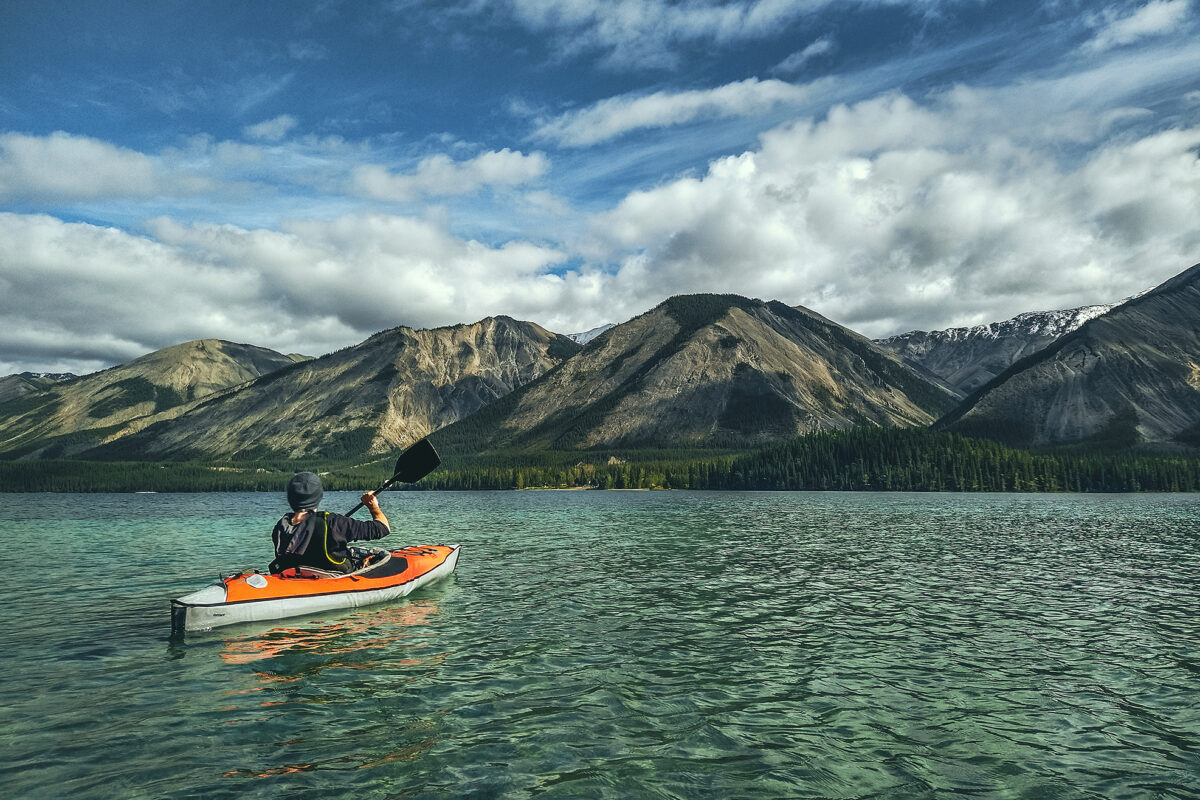
That morning we headed to the Watson Lake rec center to use the showers, for about $6 each. What a treat to have a hot shower after a week of sponge bath/wipes! Then we got on the road and left Watson Lake, and shortly after, the Yukon, as we started the last leg of our trip driving back down into East Northern BC.
While we hadn’t seen a huge amount of wildlife so far, we got to make up for it with quite a few bison sightings along the way. We first saw an isolated male, and later a couple of herds, just grazing on the side of the road.
One of the stops I was most excited about was the Liard Hot springs.
The hot springs are the second largest in Canada, and as of a couple of years ago, it was the first provincial park with a completely fenced out campground, in order to prevent human/wildlife interaction. That said the fence only protects the campgrounds, and you have to leave the enclosed area to go to the springs.
The main pool is accessible via a short boardwalk across warm swamps, where Moose sighting are apparently frequent (we didn’t see any ourselves). The warmth of the springs has allowed a lush and diverse vegetation around them.
The hot springs admission is $5 per person, or included in the $26 if you register for a campsite for one night.
The setting is quite nice, there’s a boardwalk with changing rooms on the side of the pool, which is otherwise surrounded by boreal forest and lush greenery. Although man-made, the infrastructure is well integrated in the natural setting and it does feel like you’re in the middle of tropical forest.
The hot water source is on the right when looking at the pool from the main deck, and water in that area gets quite hot, but is cooled down by multiple streams of cold water trickling from the mossy edges of the pool on the forested side.
It was a rainy day and the pool wasn’t too busy, 20- ish people maybe, but it didn’t feel crowded. I can only imagine how busy it might get in the height of summer. We stayed in for a bit, enjoying a dip in hot water for a change. Then it was time to head out.
We contemplated staying at the campground, but it only had 1 spot left and it felt a bit too crowded for us. So instead we drove to the first campground on Muncho Lake. I had read that it was very popular and you had to be there early in the summer to get a spot but on the last Monday of August, and a rather rainy one at that, our odds were pretty good! And in fact it wasn’t very busy at all.
There are 3 sections of 5 campsites pretty much on the water and a few of the spots in the second and third sections were taken, but there was no one in the first section, nearest the entrance, so we set up at one of those spots. When looking at the forecast, I had seen that rain would continue for the next couple of days. But that night the sky cleared out and we didn’t have any rain- although it got a bit cold at night. Driving out to Muncho Lake rather than staying at Liard hot springs was definitely the right decision.
The next morning we woke up to sun and pretty clear sky. Despite visiting at least two dozen lakes along the way, we hadn’t yet used the kayaks. But today was the day, especially looking at the turquoise colour of the water.
We paddled around for a couple of hours, enjoying the calm water and crossing to the other side to admire the emerald green patches of water above sandy ground. With the mountains in the background it couldn’t have been a more perfect place to take the kayaks out, even if it was the only time.
We continued to enjoy the waterfront while having lunch and then it was time to head out.
Leaving Muncho Lake we came across another wildlife family we hadn’t encountered before: Stone sheep
The drive to Fort Nelson, which cuts through the Northern Canadian Rockies, was quite spectacular. We went through several narrow valleys, where the road winds between turquoise-coloured streams or rivers and mountains slopes on one side, and on the other, low peaks that seem to rise from the very edge of the road, snow-capped mountains dramatically layered in the distance.
With a lot of my travel planning focused on the Yukon, I hadn’t really done much research into this part of the trip, and I realized as we got there that all the good hiking near Fort Nelson was behind us, on that stretch of road we had just past. The next day we had a 4 hour drive to Fort St John, on a much less remarkable stretch of the Alaska Highway, with an AirBnB booked for the night. We didn’t really have the option to go back for a day hike – so instead I looked at hikes options passed Fort St John, and added a side trip through Tumbler Ridge a few days later.
Along the way, we relied once again on our trusty Milepost to find us a local spot to have a snack. That day we stopped at Tetsa River Lodge, to enjoy some delicious cinnamon buns on their quaint porch.
We also saw our first caribou on the road, young ones without fully formed antlers yet, as well as stone sheep right as we left Muncho Lake. No moose sighting though, it might be the only wild life that we won’t be checking off the list.
We drove through Fort Nelson and decided to continue on to a campground 30 km further to spend the night. We pitched our tent at the Andy Baily Regional Park, where we were seemingly the only ones that night.
We drove the 4-ish hours between Fort Nelson and Fort St John. The road was quite different from the previous days section through the Northern Canadian Rockies. All around was now flat land, with maybe some rolling hills from time to time, and not really anything stop-worthy along the way.
We did get to witness one of the most spectacular rainbows we’d seen on the road, and we even drove through one of its legs (spoiler alert: there was no pot of gold).
We had rented an airbnb for the night, and it was a nice break from having to set up camp and trying to stay warm outside (as it turned out, the weather had started improving though, but we still enjoyed a night in). The place was quite large and equipped with washer/dryer, which we made use of as soon as we arrived. We reset and reorganized the car and I did a good clean-up of our cooking gear. Then we headed out to the store, for some dinner ingredients, as well as to pick up some beer from a local brewery.
It was quite nice to have a night in and cook dinner in a real kitchen – it’s funny how the most mundane things become exciting when you’ve been living without them even for a very short period of time. Not to mention the nice hot shower of course, and putting on some clean clothes!
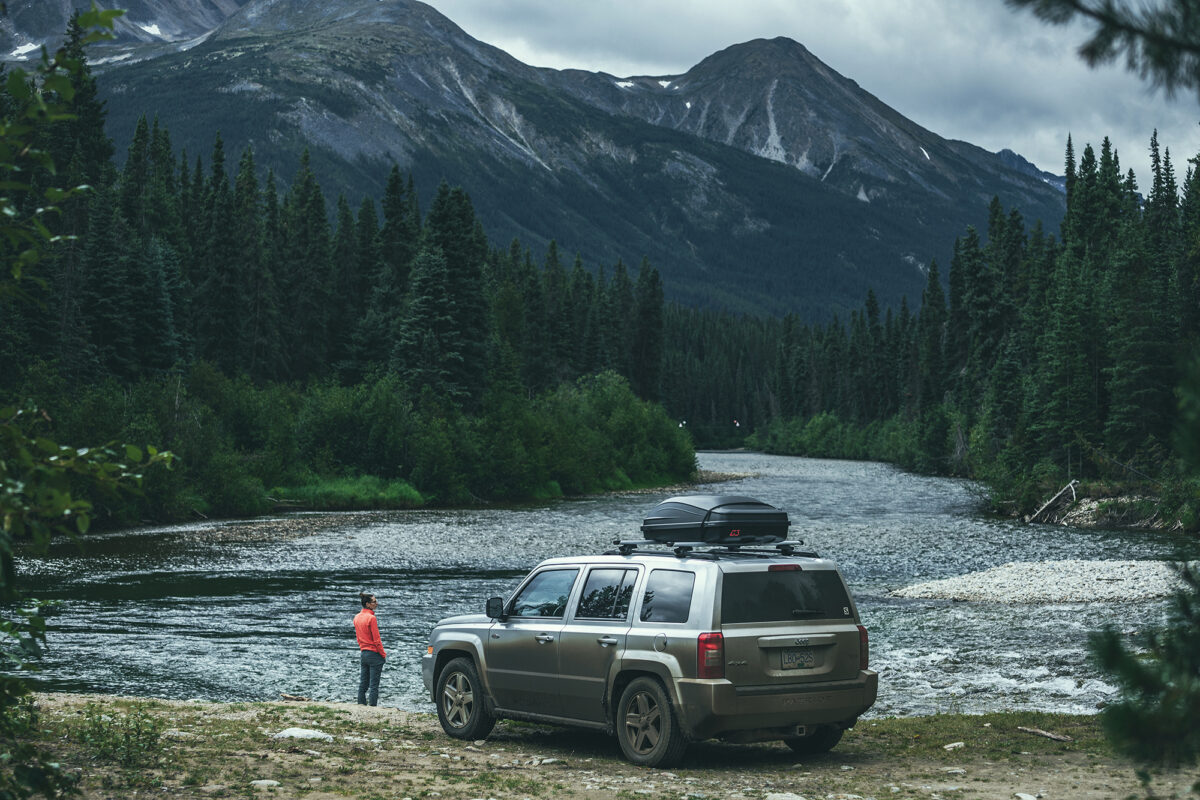
On our last morning in Stewart, we grabbed pastries at Temptations bakery (raided it, really more like) and had a couple for breakfast in the park area off Main st. Then we got back on the road, driving back East to Meziadin junction, before heading north again on highway 37, also known as the Stewart-Cassiar Highway.
The road was pretty unremarkable at first, except for 1 grizzly bear we saw right off the side of the road.
After the Ningunsaw pass, we stopped at Bob Quinn Lake for lunch.
We started seeing bigger mountains on either side of the road, although a lot were covered in clouds. I was actually a bit bummed out by the weather, as I had hoped we could take the kayaks out for a nice paddle at one of the many lakes we passed, but the cloudy, windy and low temp weather didn’t feel very conducive to a water adventure.
I had also looked at the forecast for Whitehorse and Dawson city and it looked like a whole lot of rain coming up, which I wasn’t so thrilled about. But I guess it’s better to go expecting poor weather and be glad if/when the sun comes out, than the other way around? We had been warned by our friend Adele, who had done a similar trip a few years back, that they had gotten a lot of rain, so I was somewhat prepared for it, but still a bit annoyed when it turned out to be a daily occurrence.
I should note that this whole section of road is quite isolated, with little to no cell service and very few places to stop for gas (but not far enough apart that you would need to carry an extra container of fuel).
The one bit of excitement that day came when we decided to drive down a dirt road to see where it would lead (we didn’t have any indication that it would lead to anywhere particular, but sometimes you end up in a cool scenery by taking a random side road).
After driving 10 or 15 minutes down the path, we got to a bridge over a river and Brice asked me to drive over it while he was getting some drone footage. He got in the car with me and we crossed, but hit a fairly big drop upon touching the other side, car bumper hitting the ground heavily.
I turned the car around and we went to look at the drop. It was actually a pretty significant hole, at least 2 feet wide and 5 feet deep, across 3/4 of the width of the bridge, leaving only about 2 feet of connection between the bridge and the ground. No idea how I even managed to drive through it in the first place. It’s possible the hole was a bit smaller and a bunch of dirt fell off under the weight of the car. We tried driving back through, as close to the connected side as possible, but the right front wheel would dip into the hole and spin, unable to find traction, with the bumper resting on the edge of the bridge. For a moment I was slightly concerned that we found ourselves stranded down this random road with no cell reception, but we quickly started looking around and figured we could build a makeshift platform to connect the gap.
Thankfully we had all the equipment needed in the car, and lots of fallen branches around to chop up and strap into a small bridge, which the car was able to drive over. While I was pretty relieved to see the car back on the other side, Brice says he was never worried as we had everything with us to figure out a solution. Takeaway from this: always check the full condition of the bridge, before driving across it.
After the bridge mishap and getting back on the main road, we made another bit of rookie mistake a bit later on (seems like it was the day for it).
On the map I had seen a short trail leading to a lake. We got to a spot in the road near where the trailhead should be, and actually saw people returning from the trail, so we started walking down it without even checking for a sign or anything (which is VERY unlike me).
As we walked down, the trail kept going and we realized:
After that realization, and walking down another 15min without seeing the end of the trail, we just turned around and walked back with lots of loud singing and noise making. Turns out it wasn’t even the right trailhead to access that lake, the correct one was a bit further, and a few kilometers out and back, so we decided to skip it and go to a lake we could drive to instead.
We also had had our quota of lake for the day, having stopped at Bob Quinn lake for lunch, a rec site with dispersed camping, and at the Eldontenajon lake rest area (the lower area right by the lake) for a snack later. There was definitely no shortage of lakes off the side of the road.
I had pinpointed Tatogga as our place to stop for the night but we ended up driving just a bit further. We set up camp at Morchuea lake Rec Site, a pretty scenic lake with views of Mount Edziza, but probably the highest concentration of mosquitoes we’d seen so far. For the first time on the trip we made use of our bug jackets, pretty invaluable to keep calm when trying to set up camp in a swarm of hungry mosquitoes. And thankfully the net shelter did a good job at keeping them out as well, and ensuring a relaxing evening.
As a side note, Mount Edziza wasn’t on the list for this trip as there is no road access, and it would be a whole other trip to plan on its own. But our friends Adele and Thierry’s trip from a couple of years ago certainly made us want to put it on the list for the future.
Given the poor conditions at the Morchuea lake Rec Site (mainly the fierce mosquitos), we had packed most things into the car the night before, as we knew we wouldn’t stick around for breakfast.
It rained quite a bit that night but it stopped by the time we got up. We had put the tarp over the tent for the rain but also to create a vestibule preventing mosquitos to come in, which prove pretty effective (our tent does come with an extra vestibule that you can zip on, but we’d only ever used it once, found it a bit cumbersome, and didn’t think to bring it on this trip).
We left camp and drove to the closest gas station for a refuel and coffee..
Then we drove to Dease Lake. BRMP indicated a hot spring nearby but at that scale, the map was a bit vague and didn’t describe a clear access point. We looked for it in the forest along the stream but couldn’t find it. If it existed, it definitely wasn’t one that was advertised by the locals.
We picked groceries up and some lunch, then decided to drive down Telegraph Creek Road, to get a peek at the Stikine River Canyon, described as the “Grand Canyon” of Canada. While the road goes for over 100km to Telegraph Creek, the Milepost indicated a good viewpoint at around 60 km, which is what we were aiming for. Unfortunately, we somehow missed the big sign at the beginning, saying that the road was closed for work at around km 40, and only found out when we got to a road block and a construction worker told us we couldn’t go through. So we turned around, but still found a spot with view of the river for lunch.
It wasn’t all wasted as we got to see a lynx off the side of the road, as well as a porcupine, neither of which we’ve ever seen in the wild!
The road wasn’t paved but was very smooth and easy to drive, so we traveled relatively quickly. But didn’t realize until we stopped for lunch how dirty the car had gotten, with layers of mud accumulated into the wheel wells.
We then drove back to Dease lake, to continue our way up the Stewart-Cassiar highway into the Yukon, and we made a couple more stops on the way to Watson Lake.
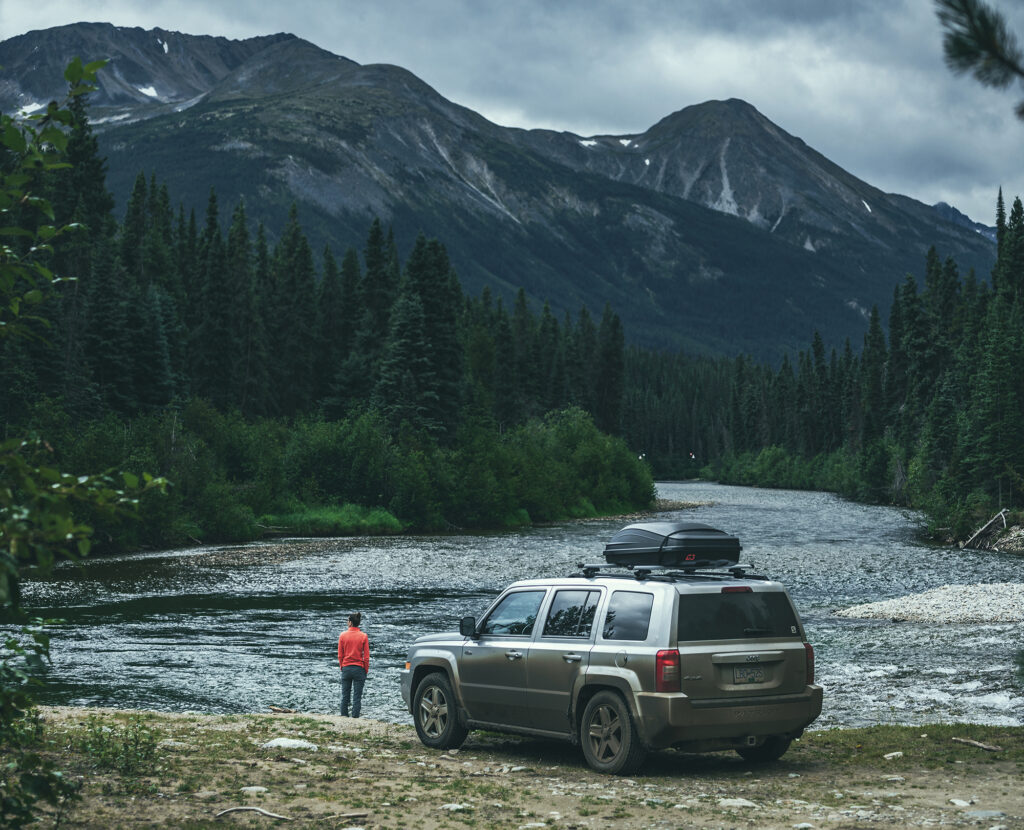
First we stopped at Jade City – which is really more of a trading post, featuring a store off the side of the road that sells all things stones & crystals and specializes in jade, as there is a large resource of it in the area.
We made a quick stop at Good Hope Lake to admire the colour of the water, changing with the movement of the clouds.
Finally we arrived at one of the places I had read about and was on the list of “must see” stops: Boya Lake
Boya lake Provincial Park is evidently a very popular camping destination and that is not surprising. The lake has shades of blue waters that make it look like the tropics. Islands are peppered all around and campsites line the shore, right on the water. The campground was pretty much full, but we weren’t planning on staying there for the night anyways, only spend a few hours and maybe get on the water.
I regretted a bit getting there late – it was already 6pm and we had another 1.5 hour drive to Watson lake. With more time, I would have loved to take the kayaks out on the lake. It was one of the potential paddle stops I had originally planned, but with the weather that morning I didn’t think it would be nice enough to do so, hence the Telegraph Creek detour. But oh well, that’s how it goes, plans don’t always work out and that’s ok. We still got to enjoy the sight of the lake in the sun and really got a sense of how beautiful the water was. Mosquitoes however were still pretty relentless. We had a snack in the day use area then took a quick walk on the trail along the lake before heading out.
We got back on the road and drove to Watson lake to spend the night, stopping only to snap a shot of the Yukon sign as we crossed the provincial/territorial border.
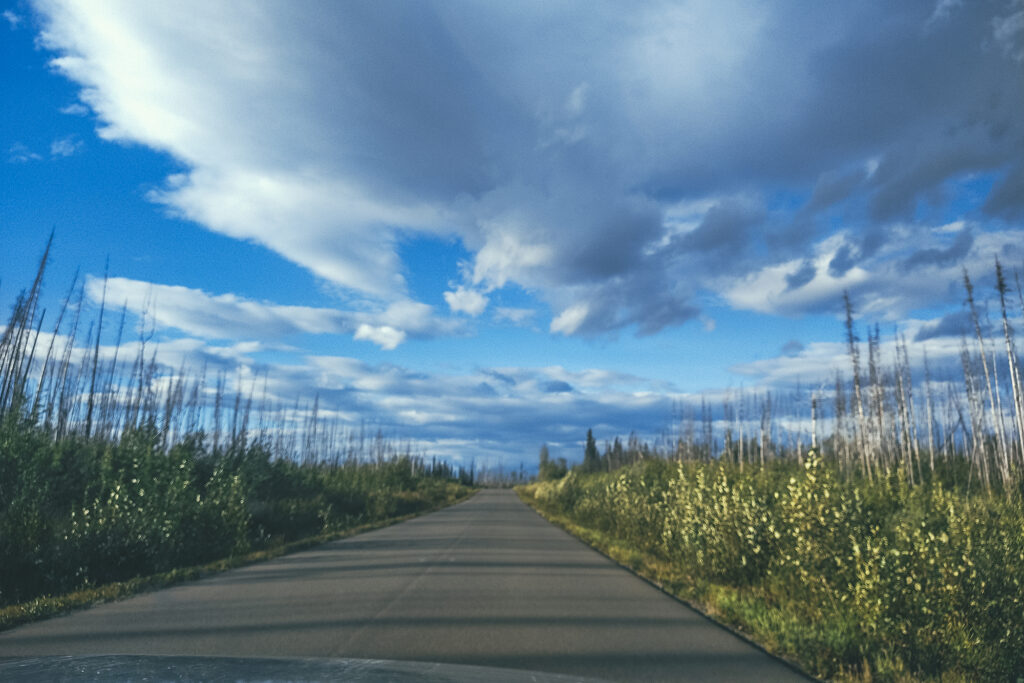
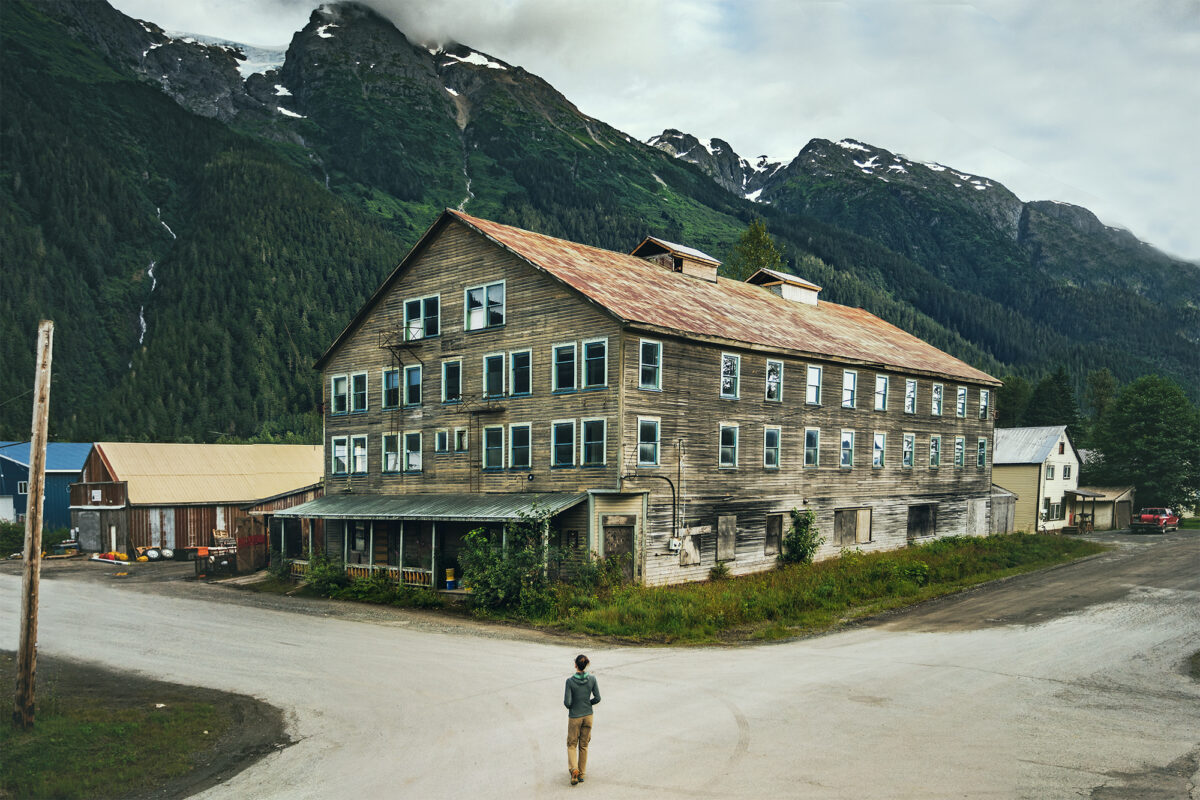
Before leaving the Nass valley that morning, we took some time to check out the two lava flow trails near the campsite. The visitor center at the entrance of the campground was open, so we walked in to read more about the the volcano eruption.
The Nisga’a oral tradition tells the following story of how the volcano erupted (from nisgaanation.ca):
Long ago, two children were playing down by the river. One child caught a salmon and slit open its back. The child stuck sticks into the salmon’s back, set them on fire, and returned the fish to the river. The children were amused to see the salmon swim erratically, smoke rising from its back. The other child caught a salmon and slit open its back, inserted a piece of shale, and put it back into the river. The salmon floated on its side, weighed down by the shale. The children laughed at the struggling fish. An elder happened upon the scene and warned the children, “Take care what you do. The salmon will curse you and the Creator will respond in kind.” The ground began to tremble and shake. Nature’s harmony had been upset. A scout was sent to investigate. From the top of Gennu’axwt, he saw smoke and flames and ran to warn the people of their fiery destiny. In panic, some villagers fled up the mountain. Others canoed to the far side of the river but were killed by the lava. As the people watched the lava flow over their villages, Gwaxts’agat (a powerful supernatural being) suddenly emerged to block the lava’s advance. For days, Gwaxts’agat fought back the lava by blowing on it with its great nose. Finally, the lava cooled and Gwaxts’agat retreated into the mountain where it remains to this day.
The shortest way back to Highway 37 is via the continuation of the Nisga’a Highway, east of Gitlaxt’aamiks. The road is barely more than a dirt track, and a bit narrow in parts so I could see how it would be a bit challenging for big RV’s, but our Jeep had no issues.
Upon reaching Highway 37, we headed north to Meziadin junction, and stopped at Meziadin Lake, a really pleasant provincial park and campground, with RV spots right on the water.
We had lunch and Brice chatted with another traveler about RVs and brake systems, etc…We’ve been enjoying sleeping in a tent so far, but I could definitely see how traveling this way for a long period of time would warrant a more sturdy set-up. We saw some really big rigs along the way, people whose home was basically on wheels and traveled up and down the country year-round. To that effect, we saw lots and lots of campgrounds and RV sites along the way, and never had any issue finding a spot to camp – although maybe our timing had something to do with it, as campgrounds might have been busier earlier in the summer.
After this lovely sunny break, we got back on the road and headed west on Highway 37A, towards Stewart. On the way we stopped to admire the imposing Bear Glacier, which is visible right off the side of the road.
The town used to have a population of about 10.000 at the start of the 20th Century, thanks to gold and silver mining, but it is now down to roughly 500.
It is still a tourist destination, set in quite a scenic spot, on the edge of the Portland Canal and framed by mountains on either side. It is also right on the border with Alaska – although there is only one small hamlet on the other side, Hyder, AK, population 40! We drove to the “border”. There actually isn’t an American custom to get in, but there is a Canadian one to come back. As expected due to Covid, the border had a big sign indicating “locals only”, so it confirmed that we weren’t going to be able to cross into the US on this trip.
When we got to the campsite, we asked the manager about the border and she said that if we crossed, we’d have to isolate for 14 days upon returning – since there was no way of getting a Covid test done on the other side. We asked about the people in Hyder, who have no other road access to the rest of the continent, let alone the US, and she said they were basically stuck there, only allowed to come into Stewart once a week for a few hours, to get groceries.
I had hoped that we could drive all the way to Salmon glacier in Alaska, which can be seen off the side of the road, but that clearly was off the table. We still decided to stay 2 nights in Stewart, to get some time off driving and explore the area near town.
The weekend we arrived happened to be Stewart Community days, so there was a BBQ happening in the town park. We took a stroll down the boardwalk that stretches over the marshy ground of the inlet, right off of Main St, and chatted with a retired couple who had sold their house and were now living in their RV year-round, traveling around Canada and the US.
We also walked down the few blocks on and around Main Street, lined with old-timey shop fronts. The rest of the central area of town looked half abandoned, including the very spooky hotel. We did see a few newly-built houses here and there, but the town definitely had a bit of a ghost town feeling in some areas.
The main campsite was located right on the edge of town, so we were able to walk to and from there easily, a nice break from all the driving.
In the morning, we had breakfast at the Rookery, local joint which doubles as a toaster Museum (aka Toastworks) displaying an impressive collection of toasters and other vintage looking artifact.
I was looking for a potential hike to do that day, but there weren’t many listed on BRMP or AllTrails, and most of them seemed to involve some amount of bushwhacking, plus the mountain tops were all covered in clouds, with no sign of clearing. So we opted to drive out to nearby Clements lake instead. It turned out to be a lovely little lake with even a small dingy left on the shore – for anyone to use we assumed.
So we did and paddled around for a bit, then had some lunch.
In all we spent about 3 hours there, then we drove back and stopped at a few scenic spots along the river. Eventually we got back to camp and spent some time relaxing by the fire.
Later on we went into the local grocery shop and were quite surprised to see how well stocked it was, with little quantities of everything – which I guess it would have to be when the nearest store is otherwise several hundred km away…
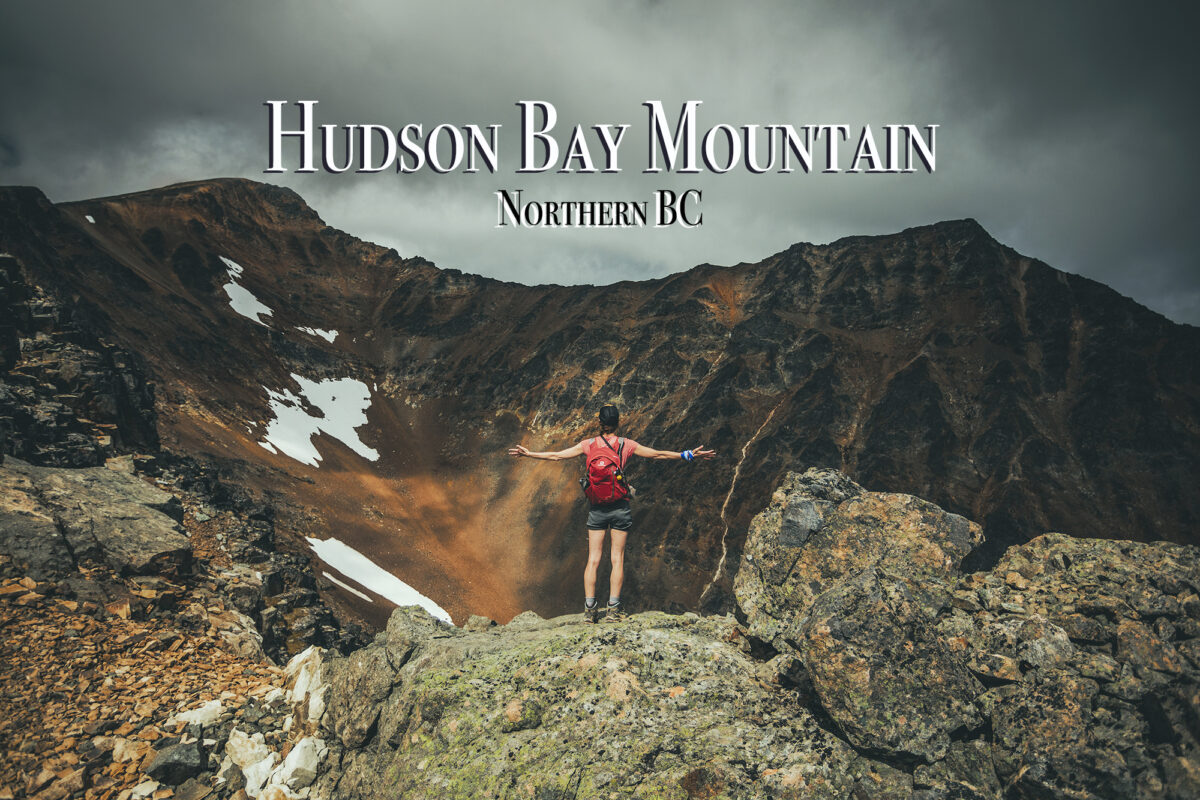
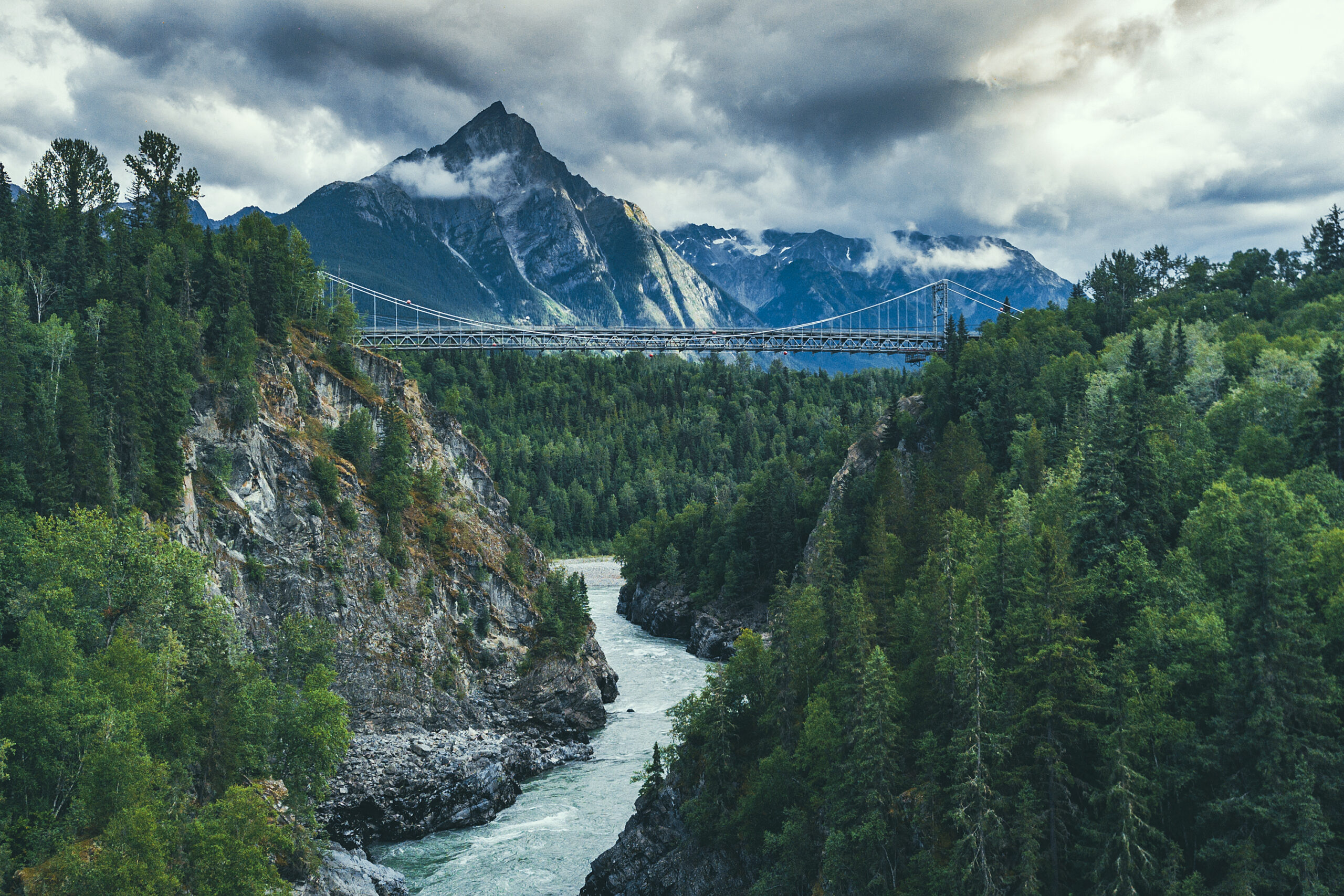
We got up and packed up camp, then headed to Smithers for breakfast and a stroll – We grabbed pastries at Paul’s Bakery and enjoyed them, along with a coffee at the outdoor space behind the Bugwood Coffee stand. Then we took a walk down the three or four blocks along Main St.
Smithers is located on the traditional land of the Wet’suwet’en Yintikh Nation, who live along the Buckley river and Burns Lake.
Smithers has a classic small town vibe of old vs. new: Second-hand bookstore and family-owned butcher shop and bakery, meet new “hipster” stores selling everything clay and linen, a buzzing brewery and an outdoor coffee stand with public piano. It’s a bit of a mixed feeling to witness another old timey town evolving into the same format of “modernity” that has spread in many places. When you’re in one of these newer shops, you could really be in any town in North America, it gets harder to pin-point a town’s identity or original cultural make-up. I guess it’s a good thing that small towns stay alive but it doesn’t feel like the change involves much of the indigenous peoples of the area, who remain on the fringe of the evolution.
Leaving Smithers, we headed out for a quick visit of Twin Falls, two waterfalls that originate from the Kathlyn and Toboggan placiers – one of which we saw from above the day before. The falls are very accessible, with a viewing platform 5 min down the trail, and another viewpoint almost at the base, another 3 minutes further. After a quick picnic, we continued North to the Hazeltons.
The Hazeltons refers to two small towns, on either side of the Hagwilget Canyon. Old Hazelton is located in the Gitanmaxx Band territory. The Old Town is more or less 2 blocks of of pioneer-era Buildings, most of which have been repurposed for modern use but preserved in their former state. Our Airbnb actually happened to be a small laneway house at the back of one such old town building, now a residence & guest house.
Before settling down for the day, we headed to the ‘Ksan historical Village & Mureum. The site is a replica of a traditional Gitxsan village. Gitxsan people have lived at the confluences of Buckley & Skeena river for over 8000 years and the museum is a great showcase of their ancient but still observed traditions.
We visited 3 longhouses, the building where members of one clan, or family, gather to celebrate special occasions and organize potlatches.
Each house displayed items of every day life, including Bentwood boxes, made by folding Cedar sheets after steaming them to make them pliable. Traditionally, most common items where made of cedar, including some clothing. Other material used included copper, which made the shield of the chief, a well as was used for helmets and decorating or dyeing garments. Copper isn’t native to the area but was a abundant resource of the Nass Valley, home of the Nisga’a people, with which the Gitxsan people traded often.
The village also displayed many totem poles and we had the opportunity to listen to a resident Carver, who explained his process in carving a pole, from inspiration, to design to the actual carving.
After the Museum, we headed to our airbnb to unpack and have a snack. It was probably one of the coziest, most well set-up place we’ve stayed at!
There was still lots of dailight time ahead of us so we drove to the Hagwilget Canyon & Bridge to check out what the Northern BC guide referred to as “one of the most photographed places in Canada” and also one of the highest suspension bridge in the country, hanging 262 feet above the river. It is surprisingly “un-secure” as the railing is barely waist-high and it wouldn’t take much to jump or fall over. I’m not usually afraid of heights but I felt much more comfortable walking down the center of the bridge (on the road) rather than the side.
We managed to find a trail descending halfway into the Canyon for a different view of the bridge and the river below.
Stegyawden, a Tsimshian name meaning, ‘painted goat’, is also known as Hagwilget Peak or the Roche de Boule mountain range. It’s a prominent mountain in the area and its peak can be seen from many locations.
As we walked back to the car, a man who we had seen walking along the river bank earlier, approached us and gave us an eagle feather from several he had collected at the bottom of the canyon. He offered it as he wished us welcome to his village and an enjoyable stay.
We made one more stop before calling it a day, by driving to Kispiox, 10km north of Hazelton, to see the totem poles displayed in the town. They stand where there was once the site of a Telegraph building post. At some point, settlers were trying to build a telegraph line to Asia, but the project was stopped before it was completed and the site abandoned. The miles of wires left behind became a source of supply for the indigenous peoples nearby.
We had a lovely evening at the airbnb, making use of the well equipped kitchen weirdly though I didn’t sleep very well. I got up at ن 3am and as I went to the bathroom, realized the toilet seat was up, which was weird as I was the last one to use the bathroom and I knew i hadn’t left it that way.
I kinda rattled me as I couldn’t make sense of how it ended up that way my two explanations, after all plausible ones were exhausted:
an animal spirit who entered the bathroom in the form of a beetle, which I found on the floor and probably came tangled in our tent when we hang it in the shower to dry – OR – a ghost from old-timey old town. Either way, some cheeky immaterial being clearly played a prank on me and I couldn’t fall back asleep for 1.5 hour after that.
We left Hazelton and headed south west towards Terrace. The drive was pretty uneventful but scenic in places, as we drove along the Skeena River. We made a quick stop in Usk, to see the small ferry crossing, built in 1913.
Terrace is a bigger town with strip malls, we didn’t stop and kept going, this time aiming North on Highway 113, aka the Nisga’a highway. After a few kilometres of road lined with houses, trees took over and it was more or less nothing but dense forest on either side, for the rest of the way.
We made a stop at Kitsumkalum lake for lunch. The lake is indicated as a provincial park on BRMB, but there wasn’t any sign pointing to the entrance. We saw an unmarked road going down near where the entrance was indicated on the map, so we drove down it and sure enough it took us to the lakeside. The site is labeled as a “user-maintained” so it was pretty rudimentary. The road was very pot-holed and for once, I didn’t even want to take a look at the outhouse.
We kept driving until we started seeing signs for the Nisga’a Nation auto-tour, which indicates various points of interest in and around the Nisga’a Lava flow.
We first stopped at the drowned forest, where the stream of the Treax river rushes through the trees, covering the ground around them (hence the name “drowned”).
We stopped at Lava lake, then at a couple of scenic water falls along the way. Eventually the trees disappeared, instead replaced by the dramatic landscapes of the lava flow.
Less than 300 years ago, a volcano in the Nass mountain range, the Treax Cone, erupted violently and the lava from the eruption covered a large area of the valley, destroying several villages and taking the life of an estimated 2000 indigenous people..
The solidified lava that remains today has high cultural significance for the people of the Nisga’a nation, and only a few marked trails allow venturing around the rock features.
Due to Covid, all tourist services and attractions were closed, including the museum, the hot springs, and any cultural event that would normally be held and open to visitors.
I had planned for us to spend the next day driving out to Gingolx, the furthest village at the end of the Nass valley, and making stops along the way. But without access to any of the afore-mentioned activities, it was ultimately only a 2-hour drive and back.
It was 4:30pm when we got to the small visitor center, so we decided to take the drive out to Gingolx, if only for the scenery along the way, and come back to spend the night at the Nisgala Memorial Lava Bed Park Campground which was still open for use.
There are four main villages of the Nisga’a Nation along Nass Road, which travels paralell to the Nass River. Gitlaxt’aamiks is the eastern most, more or less located at the intersection of the Nisga’a Highway and Nass Road. Next is Gitwinksihlkw, with its scenic suspension bridge, Lax̱g̱altsʼap is home to the Nisga’a Museum. Ging̱olx is the last village, at the mouth of the Nass River.
We stopped at the Gitwinksihlkw suspension bridge then later down the road saw a bunch of eagles perched on rocks and stumps by the river. They looked young, as not all of them had white heads and their feathers looked pretty shaggy (we had binoculars to look at them).
Eventually we made it to Gingolx, which sits at the very end of the road and on the scenic shores the river mouth. We had a snack then made our way back to the campground for the night.
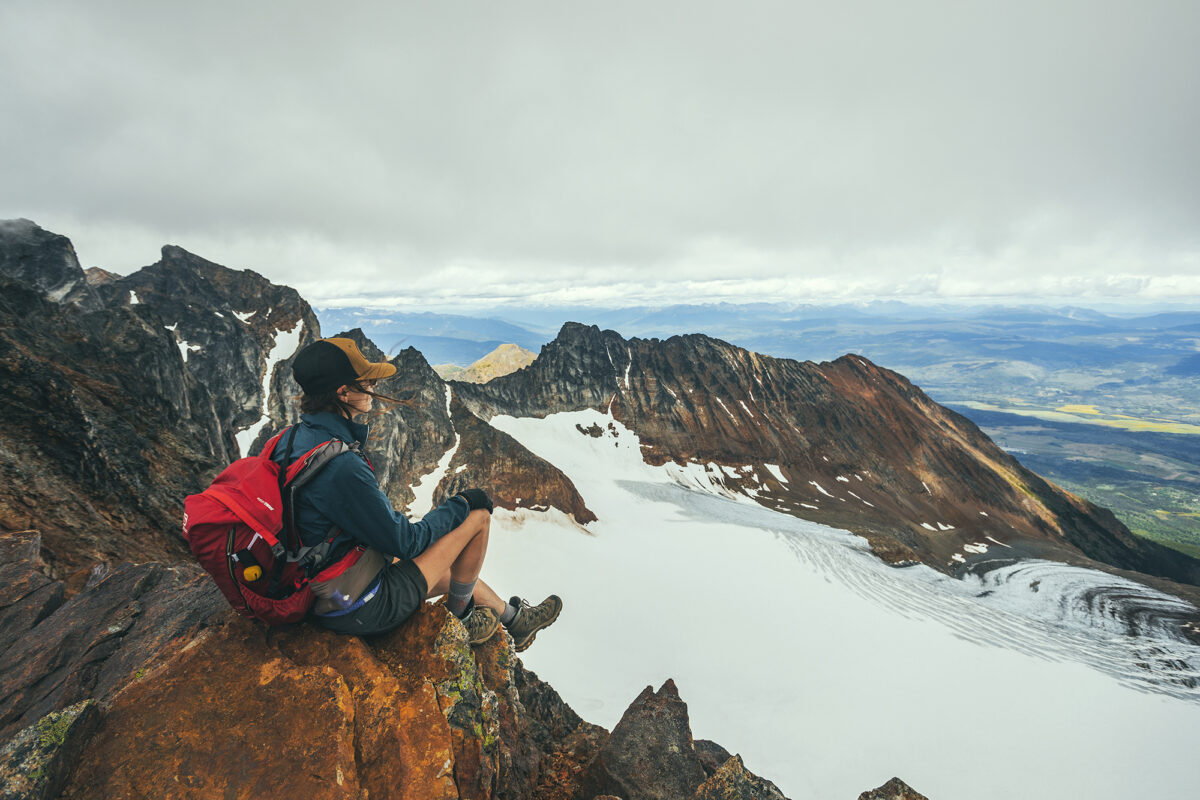
In the summer of 2021, after 2 years of working through a very challenging project, not to mention a world-wide pandemic, I was able to take 2 months off work. Yukon had been on our list of places to travel to for a bit, and with flying and travel restrictions still in place, it seemed like the right opportunity to take this trip.
I kept a journal as we drove through Western Northern BC, into the Yukon, up to Tombstone Territorial Park, back down to Kluane National Park, then down through Eastern Northern BC before returning to Vancouver. The next few posts are a transcript of that journal, complemented by the 1000s pictures we took along the way…
That summer, BC experienced a gnarly heatwave (due to a meteorological “heat dome”), followed by dramatic wildfires spreading in all areas around the lower mainland. When we left Vancouver around 10am on Aug 2nd, I was a bit worried about the wildfires in the Okanagan, and what that would look like for our itinerary. Looking at the Emergency BC App and the BC Wildfire Map, I could see that the shortest route, through the Fraser Canyon, would take us right through the main evacuation alert/order zones. Not Ideal.
So instead we took a slight detour, following highway 5 through Merritt, Kamloops, and then rejoining Highway 97 via route 24. We also decided to drive further on that first day than originally planned, as the air quality at Lac La Hache, where we initially planned to stop, was not the greatest.
We drove an extra 2,5 hours past Lac La hache and landed at Chubb Lake, a small Recreation Site off the highway past Quesnel, with campsites on the water. It was a perfect spot for our first night on the road!
Although it hadn’t rained in Vancouver for weeks, the weather forecast was calling for a thunderstorm. We did get some brief, heavy rain falls on the road between Williams lake and Quernel, but no rain at the lake, only a bit of distant lightning & thunder.
That first night gave us a taste of the bug situation for a good portion of the trip. Mosquitos at the lake where quite intense, especially with being right on the water. Thankfully, one of the main pieces of gear that we purchased for this trip was a net shelter, big enough to fit over most of the picnic tables at campgrounds and keep the mosquitoes away. It turned out to be a game changer for our camping experience, acting as both a bug shield and rain cover (with the added help of a big tarp), and ultimately creating that homey feeling every night, after we’d set up everything on the picnic table.
We’re not used to packing this much for a trip, generally limited in weight when flying somewhere, or if we’re going backcountry camping. But since we were driving, we were able to bring a lot more along, including the extra comfort items such as a table (we ended up not using it since all campgrounds had a picnic table) chairs, shelter and extra tarps, boxes of food, two-burner cooking stove, etc…. We even brought an extra tent (didn’t end up using it) as well as a back up sleeping mat (which we did use when my mat got punctured).
After packing up camp, we drove to Prince George and stopped at our first (of many) local bakery for pastries, at a place called Pastry Chef Bakery. Then we got back on the road for another day of driving. We stopped at Beaumont Provincial Park for lunch, and enjoyed a picnic in the shade with view of Fraser Lake.
After a few more hours of driving, we arrived near Smithers, and set up camp at the Tyhee lake Campground 10 min south of town. Since we were one day ahead of schedule, we decided to stay two nights.
Thanks to recent rain, the fire ban had been lifted for the area, so we were able to enjoy a nice campfire that night, always a big part of the camping ambiance.
Since we set up camp for 2 nights at Tyhee Lake, we were able to take a day off driving and go out for a hike. Our friend Adele had mentioned Crater lake as a good hike, so we decided to go for it.
The trail starts from the Hudson Bay Mountain resort, and thanks to the road taking us a good way up in elevation, we reached alpine meadows within just a few minutes of starting the hike.
From there, we had views all the way to the top. In only took us about 40 min to reach the lake, so we kept going right away, along the ridge.
From the top of that first section, we found ourselves overlooking a steep chute and couloir – probably be a great ski objective for more adventurous backcountry skiers.
After that, the trail was a bit more faint, traveling over rocks and scree, but it was easy to aim for the next summit. This time we looked over the edge to an impressive glacier.
We saw that there was one more climb possible to the top of a prominence that from afar, looked like a dorsal fin, but clouds were coming in and the wind was strong so we decided to head back down. We stopped at the lake for a quick break before heading down through the meadow, back to the car.
On the way back to camp we stopped in Smithers to grab some beers at the local brewery and give the small “downtown” strip a first look.
There were hot showers at the campground, which we much appreciated after after having a good day out. It rained pretty strong that night but it had stopped by morning so it wasn’t too much of a pain to pack everything up, even with both tents being wet.